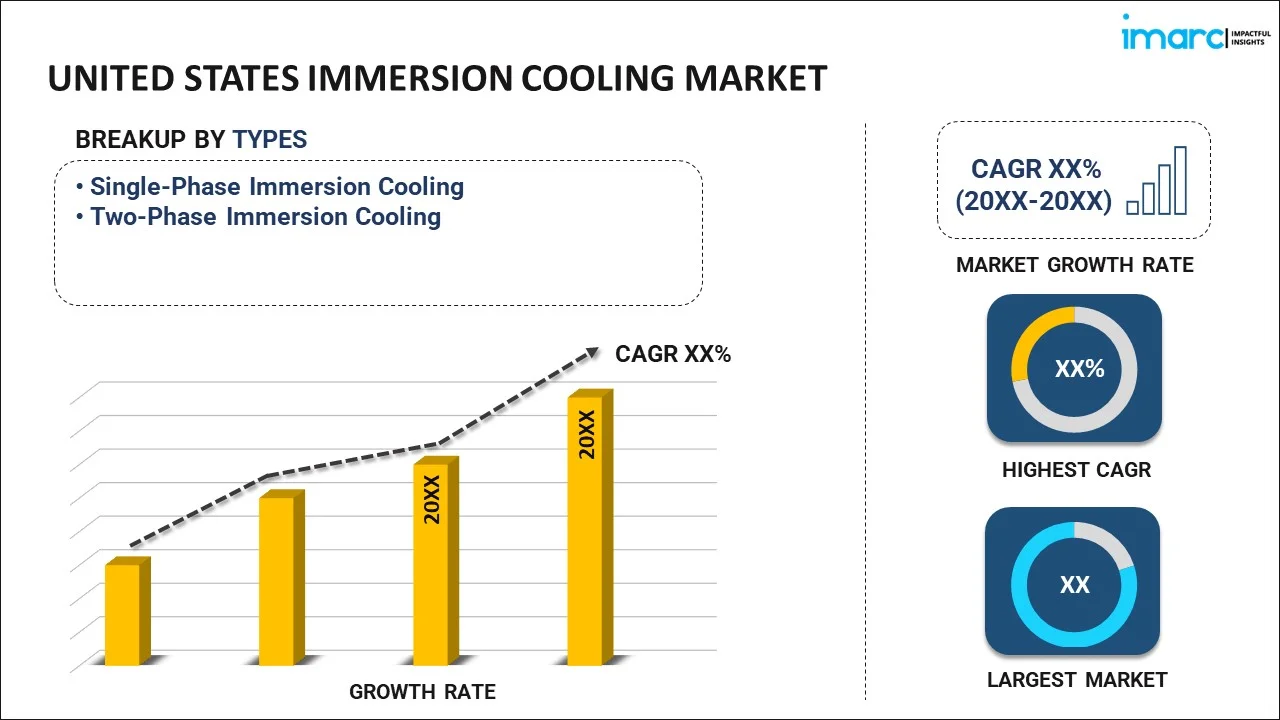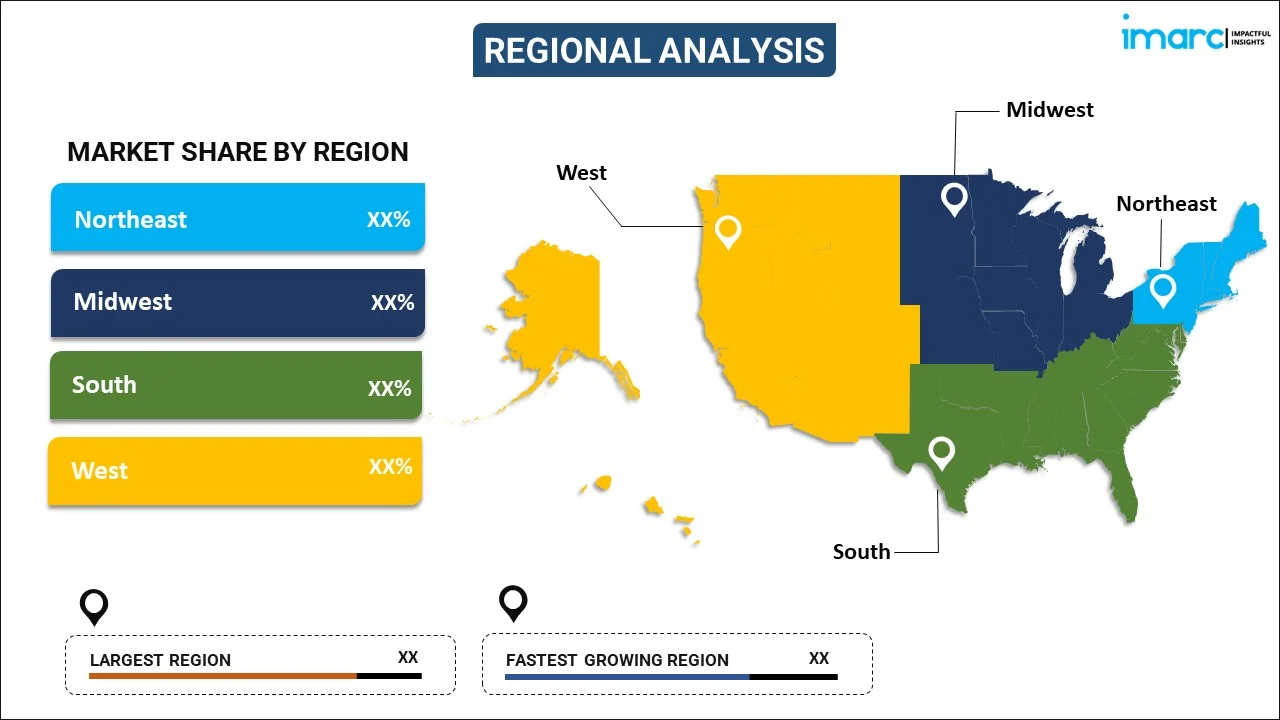
United States Immersion Cooling Market Report by Type (Single-Phase Immersion Cooling, Two-Phase Immersion Cooling), Cooling Fluid (Mineral Oil, Synthetic Fluids, Fluorocarbon-Based Fluids, and Others), Application (High-Performance Computing, Artificial Intelligence, Edge Computing, Cryptocurrency Mining, and Others), and Region 2025-2033
Market Overview:
United States immersion cooling market size reached USD 75.5 Million in 2024. Looking forward, IMARC Group expects the market to reach USD 401.5 Million by 2033, exhibiting a growth rate (CAGR) of 20.4% during 2025-2033. The escalating demand for scalable and high-density computing solutions, the expansion of the cryptocurrency mining industry, and increasing collaborations between academic institutions, technology companies, and government agencies represent some of the key factors driving the market.
|
Report Attribute
|
Key Statistics
|
|---|---|
|
Base Year
|
2024
|
|
Forecast Years
|
2025-2033
|
|
Historical Years
|
2019-2024
|
|
Market Size in 2024
|
USD 75.5 Million |
|
Market Forecast in 2033
|
USD 401.5 Million |
| Market Growth Rate 2025-2033 | 20.4% |
Immersion cooling utilizes dielectric fluids that are non-conductive, preventing electrical components from short-circuiting. It is highly efficient and can dissipate heat more effectively than traditional air cooling methods. It helps reduce energy consumption compared to air-based cooling systems by maintaining lower operating temperatures. It ensures that electronic components operate at their optimal temperatures, resulting in improved performance and longevity. It minimizes the need for energy-intensive air conditioning, leading to lower energy bills and reduced environmental impact. It often requires less physical space as compared to traditional air cooling systems, making it ideal for data centers and crowded environments. It is widely utilized in high-performance computing clusters for scientific research, simulations, and artificial intelligence (AI) applications. Besides this, it is also employed in the automotive industry to cool advanced electronic components in electric vehicles, ensuring their reliable operation.
United States Immersion Cooling Market Trends:
The rising emphasis on energy efficiency in the United States represents one of the key factors influencing the market positively. Additionally, the growing concerns about environmental sustainability are encouraging businesses and data centers in the country to reduce their energy consumption and carbon footprint. Along with this, the escalating demand for scalable and high-density computing solutions, especially in sectors like AI, cloud computing, and data analytics, is offering a favorable market outlook. Immersion cooling enables organizations to pack more computing power into a smaller physical footprint. Furthermore, the expansion of the cryptocurrency mining industry and the rising focus of miners on maximizing their computational power and managing the immense heat generated by mining rigs is strengthening the growth of the market in the country. Immersion cooling allows miners to achieve higher hash rates while maintaining stable temperatures. This increases efficiency and extends the lifespan of expensive mining hardware. Moreover, continuous advancements in immersion cooling technology are facilitating the market growth. Several manufacturers are innovating to develop more efficient and cost-effective immersion cooling solutions. These advancements include improved cooling fluids, enhanced cooling system designs, and more robust monitoring and control mechanisms. Additionally, the integration of intelligent software and sensors is making it easier for organizations in the United States to manage and optimize their immersion cooling systems. Real-time data monitoring and predictive maintenance capabilities have increased system reliability and reduced downtime, further encouraging adoption. In addition, the rising trend towards decentralization and the deployment of edge data centers to support applications like autonomous vehicles and smart cities is promoting the adoption of immersion cooling in these facilities. Moreover, increasing collaborations between academic institutions, technology companies, and government agencies are driving innovation in the field. These partnerships are creating new possibilities and addressing the evolving needs of various industries.
United States Immersion Cooling Market Segmentation:
IMARC Group provides an analysis of the key trends in each segment of the market, along with forecasts at the country level for 2025-2033. Our report has categorized the market based on type, cooling fluid, and application.
Type Insights:

- Single-Phase Immersion Cooling
- Two-Phase Immersion Cooling
The report has provided a detailed breakup and analysis of the market based on the type. This includes single-phase immersion cooling and two-phase immersion cooling.
Cooling Fluid Insights:
- Mineral Oil
- Synthetic Fluids
- Fluorocarbon-Based Fluids
- Others
A detailed breakup and analysis of the market based on the cooling fluid have also been provided in the report. This includes mineral oil, synthetic fluids, fluorocarbon-based fluids, and others.
Application Insights:
- High-Performance Computing
- Artificial Intelligence
- Edge Computing
- Cryptocurrency Mining
- Others
The report has provided a detailed breakup and analysis of the market based on the application. This includes high-performance computing, artificial intelligence, edge computing, cryptocurrency mining, and others.
Regional Insights:

- Northeast
- Midwest
- South
- West
The report has also provided a comprehensive analysis of all the major regional markets, which include Northeast, Midwest, South, and West.
Competitive Landscape:
The market research report has also provided a comprehensive analysis of the competitive landscape. Competitive analysis such as market structure, key player positioning, top winning strategies, competitive dashboard, and company evaluation quadrant has been covered in the report. Also, detailed profiles of all major companies have been provided.
United States Immersion Cooling Market Report Coverage:
| Report Features | Details |
|---|---|
| Base Year of the Analysis | 2024 |
| Historical Period | 2019-2024 |
| Forecast Period | 2025-2033 |
| Units | Million USD |
| Scope of the Report | Exploration of Historical Trends and Market Outlook, Industry Catalysts and Challenges, Segment-Wise Historical and Future Market Assessment:
|
| Types Covered | Single-Phase Immersion Cooling, Two-Phase Immersion Cooling |
| Cooling Fluids Covered | Mineral Oil, Synthetic Fluids, Fluorocarbon-Based Fluids, Others |
| Applications Covered | High-Performance Computing, Artificial Intelligence, Edge Computing, Cryptocurrency Mining, Others |
| Regions Covered | Northeast, Midwest, South, West |
| Customization Scope | 10% Free Customization |
| Post-Sale Analyst Support | 10-12 Weeks |
| Delivery Format | PDF and Excel through Email (We can also provide the editable version of the report in PPT/Word format on special request) |
Key Questions Answered in This Report:
- How has the United States immersion cooling market performed so far and how will it perform in the coming years?
- What has been the impact of COVID-19 on the United States immersion cooling market?
- What is the breakup of the United States immersion cooling market on the basis of type?
- What is the breakup of the United States immersion cooling market on the basis of cooling fluid?
- What is the breakup of the United States immersion cooling market on the basis of application?
- What are the various stages in the value chain of the United States immersion cooling market?
- What are the key driving factors and challenges in the United States immersion cooling?
- What is the structure of the United States immersion cooling market and who are the key players?
- What is the degree of competition in the United States immersion cooling market?
Key Benefits for Stakeholders:
- IMARC’s industry report offers a comprehensive quantitative analysis of various market segments, historical and current market trends, market forecasts, and dynamics of the United States immersion cooling market from 2019-2033.
- The research report provides the latest information on the market drivers, challenges, and opportunities in the United States immersion cooling market.
- Porter's five forces analysis assist stakeholders in assessing the impact of new entrants, competitive rivalry, supplier power, buyer power, and the threat of substitution. It helps stakeholders to analyze the level of competition within the United States immersion cooling industry and its attractiveness.
- Competitive landscape allows stakeholders to understand their competitive environment and provides an insight into the current positions of key players in the market.
Need more help?
- Speak to our experienced analysts for insights on the current market scenarios.
- Include additional segments and countries to customize the report as per your requirement.
- Gain an unparalleled competitive advantage in your domain by understanding how to utilize the report and positively impacting your operations and revenue.
- For further assistance, please connect with our analysts.
 Inquire Before Buying
Inquire Before Buying
 Speak to an Analyst
Speak to an Analyst
 Request Brochure
Request Brochure
 Request Customization
Request Customization




.webp)




.webp)












